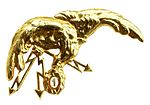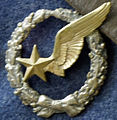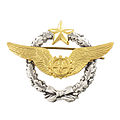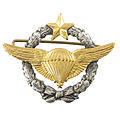Aviator badge
An aviator badge is an insignia used in most of the world's militaries to designate those who have received training and qualification in military aviation. Also known as a Pilot's Badge, or Pilot Wings, the Aviator Badge was first conceived to recognize the training that military aviators receive, as well as provide a means to outwardly differentiate between military pilots and the “foot soldiers” of the regular ground forces.
United States of America
A Military Aviator badge existed from 1912-17 before being replaced by the predecessor of the "wings" badge.
| United States Aviator Badge | |
|---|---|
 | |
| Type | Badge |
| Presented by | United States Armed Forces |
| Status | Currently awarded |
| Established | Second World War |
| First awarded | Second World War |
| Last awarded | On going |
| Army Precedence | |
| Next (higher) | Military Free Fall Parachutist Badge |
| Next (lower) | Astronaut Device[1] |
A United States Aviator Badge refers to three types of aviation badges issued by the United States Armed Forces, those being for Air Force, Army, and Naval (to include Marine and Coast Guard) aviation.
Air Force Pilot and Army Aviator Badges are issued in three ratings: Basic, Senior, and Command (Air Force)/Master (Army). The higher degrees are denoted by a star or star with wreath above the badge. Air Force regulations state that the basic rating denotes completion of specified training and that the advanced ratings denote experience levels. The Naval Aviator Badge is issued to pilots upon designation as a Naval Aviator for Navy, Marine Corps, and Coast Guard aviators who successfully complete flight training. There is a single badge design regardless of an individual’s further qualifications.
United States Air Force
World War I
The first United States Aviator Badges were issued to members of the Air Service during World War I. The badges were issued in three degrees: Observer (a "US" shield and one left-side wing), Junior Aviator or Reserve Aviation Officer (a "US" shield between two wings), and Senior Aviator (a star over "US" shield between two wings). The Army Air Service also issued a badge for balloon pilots, known as the Aeronaut Badge.
Enlisted Aviators wore their regular rank insignia and the Observer's badge. There were 29 enlisted pilots before the American entry into World War I. The second enlisted aviator, William A. Lamkey, got a discharge and flew for Pancho Villa. The remaining enlisted pilots received commissions in 1917. There were 60 enlisted mechanics who were trained as pilots in France during the war, but they were used for ferrying duties and did not fly in combat.[2] The recruiting and training of enlisted Aviators ended in 1933.
World War II


During World War II, with the rise of the Army Air Forces, a second series of aviator badges were issued to include a design that has survived to the modern day. The Pilot Badge was issued in three degrees, including Pilot, Senior Pilot, and Command Pilot. A polished silver colored version of these badges is currently used as the United States Air Force Pilot Badges.
From August 1941 to November 1942, the Enlisted Aviator program was restarted. Candidates had to be at least 18, possess a high school diploma, and have graduated at the top of their high school class. Graduates were rated as Flight Staff Sergeants or Flight Technical Sergeants and wore the same pilot's wings as officers. They were usually assigned to pilots of transport and auxiliary aircraft to free officer pilots to pilot the more prestigious fighters and bombers. Auxiliary pilots received their own special wings to indicate their status and specialty. In November 1942 all enlisted pilots were promoted to Flight Officer rank and enlisted cadets were graded as Flight Officers or Second Lieutenants depending on merit. The qualifying requirements for the Senior Pilot Wings are: Seven (7) years as rated pilot and permanent award of pilot rating. Plus 2000 total hours or 1300 hours primary and instructor flight (refer to U.S. Air Force aeronautical rating for details).
Independent Air Force
In 1947, the U.S. Army Air Forces became its own separate service as the U.S. Air Force. The Air Force use the same pilot's badges as the earlier USAAF design, except that starting in the mid-1990s, they began to be made of chrome metal or sterling silver rather than the dull alloy wings used by the Army Air Forces and Air Force from 1947 to the mid-1990s. The U.S. Air Force currently issues several aviation badges including pilot, combat systems officer (formerly navigator), air battle manager, flight surgeon, flight nurse, non-rated officer aircrew, and enlisted aircrew. The requirements to earn these are listed here.
United States Army
After the creation of the U.S. Air Force as a separate service in 1947, Army Aviation continued to a degree that warranted a new badge for Army Aviators (who piloted light observation and liaison airplanes and helicopters). The result was the creation of the Army Aviator Badge, which is a modified version of the U.S. Air Force Pilot Badge. It comes in three grades: Basic, Senior (7 years' service and 1,000 flight hours, pilot-in-command status), and Master (15 years' service and 2,000 flight hours, pilot-in-command status).[3] The Aviator and Senior Aviator Badges were approved on 27 July 1950 and the Master Aviator Badge was approved on 12 February 1957.
The aviator badge currently used in the Navy has remained virtually unchanged since it was first issued on 13 November 1917. The Naval Aviator Badge is earned by all U.S. Navy, U.S. Marine Corps, and U.S. Coast Guard pilots upon graduation from advanced flight training. Additional aviator badges exist for Naval Flight Officers (USN & USMC), Naval Flight Surgeons, Naval Aviation Physiologists, Naval Flight Nurses, Naval Aviation Observers (USN & USMC) and enlisted Naval Aircrewman (USN, USMC & USCG). Naval Aviators' badges are gold in color. Unlike the Air Force and the Army, the naval services do not employ senior or command/master aeronautical ratings.
NOAA Commissioned Officer Corps

The NOAA Commissioned Officer Corps Aviator Insignia is a gold-colored pin, winged, with a central device consisting of a fouled anchor surcharged with a NOAA Corps device. NOAA Corps officer pilots and navigators may wear the NOAA aviator insignia after authorization by the Director of the NOAA Corps.
NASA
With the dawn of the Space Age, all of the United States Aviator badges are upgradable to the Astronaut Badge, for those military members who become astronauts.
United Kingdom
The current aviator badge of the Royal Air Force has been in use since the Second World War. The badge consists of a winged crown and wreath, beneath which are the letters "RAF". The Royal Air Force also uses a "half wing" version to denote Weapon System Officers (WSOs) and Weapon System Operators (WSOps) as well as various airborne roles such as Airborne Technician.
Belgium
The current aviator badge of the Belgian Air Force is:

Canada
The brevet badge for a Royal Canadian Air Force pilot is:

Denmark
The aviator badge of the Royal Danish Air Force is:

China
The emblem of the People's Liberation Army Air Force is:

France
The aviator badges of the French Air Force/Armée de l'air française and French Navy/Force maritime de l'aéronautique navale are:
-
Pilot's Badge
-
Observer's Badge
-
Navigator's Badge
-
Flight Doctor's Badge
-
Air Force Flight Nurse
-
Air Force Patient Pilot
-
Naval Pilot's Badge
Germany
1913-1920
Several badges were donated to German aircrew prior, during or after the First World War. The most notable were[4][5]:
-
badge for navy pilots from seaplanes 1913
-
badge for observation officers from airplanes 1914
The military pilot badge (Abzeichen Militär-Flugzeugführer) was donated on January 27, 1913 by Emperor Wilhelm II. It could be awarded to officers, NCOs and crews who, after completing the two required tests for pilots and after completing their training at a military air base, acquired the certificate as a military pilot issued by the military air and land transportation inspection (Inspektion des Militär-Luft- und Kraft-Fahrtwesens). A similar badge for military pilots was donated on 4 February 1913 by Prince Ludwig from Bavaria.
The badge for navy pilots on seaplanes (Abzeichen für Marine Flugzeugführer auf Seeflugzeugen) was donated on 31 May 1913 by King and Emperor Wilhelm II, for all officers and soldiers, who successfully completed the training on a naval aircraft station and thus received a certificate of qualification as a naval pilot.
The badge for navy pilots on land planes (Abzeichen für Marine Flugzeugführer auf Landflugzeugen) was donated on 23 February 1915 by emperor Wilhelm II for pilots of the Navy, who completed their service in the war on land planes.
The badge for observation officers from airplanes (Abzeichen für Beobachtungsoffiziere aus Flugzeugen) was donated on January 27, 1914 by emperor Wilhelm II. Prerequisites for the award were: 1. a distance traveled of at least 1000 km in an aircraft, 2. a successfully completed technical assistance examination on an aircraft, 3. pass of at least one retake, 4. accomplished exploration missions, and 5. a certification as an observation officer. A similar badge was donated by King Ludwig III. on 3 March 1914 for the Bavarian army.
The airgunner badge (Abzeichen Flugzeug-Fliegerschützen) was founded on January 27, 1918 by emperor Wilhelm II. The soldiers had to demonstrate in-depth knowledge in engine construction and operation, in flight training, in map reading, in the tactics of aerial combat, in theory of bombing, and skills in the operation of machine guns on the ground and in aerial combat.
The commemorative badge for airship crews (Erinnerungsabzeichen für Besatzungen der Luftschiffe) was donated in 1920 by Reichswehr Minister Otto Gessler. There were two versions for Army and Navy airships. Upon request, it was awarded to officers, deck officers, NCOs and crews of former airship crews, who during the war had at least one year of activity on front aircraft.
1935-1945

The Pilotenabzeichen (Pilot's Badge) of the former Luftwaffe had been instituted by Hermann Göring on 12 August 1935. It came in distinct types; nickel silver (changed to zinc during the war) and a variant made of gold.[6] It depicts a silver eagle (Silberner Adler) perched atop a swastika (Hakenkreuz), wings open in a landing pose, and surrounded by a wreath with laurel (Lorbeer) on the right side and oak (Eichenlaub) branches on the left side, respectively.[7] It was worn in the center of the left breast pocket of the service tunic, underneath the Iron Cross 1st Class if awarded.[8] The badge was awarded after one completed flight training and the flying licence and citation were received.[7]
After 1955

In the Bundeswehr the aviation badge (Tätigkeitsabzeichen Militärluftfahrzeugführer) comes in three grades: bronze (Standard Pilot), silver (Senior Pilot) after 1200 flight hours and gold (Command Pilot) after 1800 flight hours. It depicts the Bundesadler surrounded by an oak leaf wreath between two wings. It is worn above the right breast pocket. A total of two Tätigkeitsabzeichen may be worn, one of which can be foreign in which case the foreign one would be worn below the German one.[9]
Hungary
1938-1945
Pilots and navigators of the Royal Hungarian Air Force wore their aviator rating badge sewn on their uniforms right breast above the pocketflap. The Observers Badge was the same, except without the Holy Crown of Hungary. A smaller version of the pilot's badge which was worn on the lower left sleeve of the overcoat - observers also worn a small insignia without the crown on their sleeve.[10] During World War II a gilded bronze pilot and observer badge was also introduced.
 |
 |
 |
After 1990
After the withdrawal of Soviet forces from Hungary a new Hungarian Air Force was created. It took on the traditions of the Royal Hungarian Air Force. There are 4 classes of pilots badges. Gold laurel 1st class aviator; 1st class aviator, 2nd class aviator, and 3rd class aviator.

 |
 |
 |
Israel
The current badge of a pilot in the Israeli defense forces is:

Namibia
The aviator badge of the Namibian Air Force is:
The Netherlands
The aviator badge of the Royal Netherlands Air Force and the Royal Netherlands Navy is:

Poland
The current aviator badge of the Polish Air Force has been in use since the 1920s. The badge is called gapa and represents silver eagle in flight with gold laurel wreath in the bill. Navigator/Observer badge (below) represents the same eagle, but in gold with added lightning bolts. The gapa is worn in the usual place on the upper left breast above the pocket, but unlike other air forces it is suspended on a chain. It adorned the uniform of Polish Air Force officers in the RAF during World War II along with their RAF wings. In the combat version (for at least 7 flights in combat conditions) the badge has a green laurel wreath.
| Badge | Pilot | Observer | |||||
|---|---|---|---|---|---|---|---|
 Air Forces |

|

| |||||
| Pilot | Observer | ||||||
| Abbreviation | pil. | obs. | |||||
South Africa
The current aviator badge of the South African Air Force has been in use since 2002, when South Africa adopted a new coat of arms. Like the RAF, the SAAF also has a half-wing version of the badge, in this case for navigators. The aviator and navigator badges comes in three grades: bronze, silver and gold. Reserve force aviator badges have a light blue inlay around the coat of arms as appose to the dark blue of permanent air force aviators.
Spain
Turkey

Notes
- ^ "Army Regulation 600-8-22 Military Awards (24 June 2013). Table 8-1, U.S. Army Badges and Tabs: Orders of precedence. p. 120" (PDF). Archived from the original (PDF) on 17 October 2013. Retrieved 12 October 2013.
- ^ "Fact Sheets : Enlisted Pilots : Enlisted Pilots". www.nationalmuseum.af.mil. Archived from the original on 7 July 2007. Retrieved 15 January 2022.
- ^ "Army Aviation - Miscellaneous". Ljmilitaria.com. Retrieved 2018-07-20.
- ^ André Hüsken (2001). Katalog der Orden, Ehrenzeichen und Auszeichnungen des Kurfürstentums Brandenburg, der Markgrafschaften Brandenburg-Ansbach und Brandenburg-Bayreuth, des Königreiches Preußen, der Republik Preußen unter Berücksichtigung des Deutschen Reiches / 3, Ehrenzeichen, Auszeichnungen und Ehrengaben 1888-1935. Bremen: Hauschild. ISBN 3897571382. OCLC 314298345.
- ^ Nimmergut, Jörg. (2001). Deutsche Orden und Ehrenzeichen bis 1945 / 4 Württemberg II - Deutsches Reich. München: Zentralstelle für wiss. Ordenskunde. ISBN 3000013962. OCLC 163184635.
- ^ Ailsby 2003, pp. 59, 60.
- ^ a b Ailsby 2003, p. 59.
- ^ Angolia 1987, p. 162.
- ^ ZDv 37/10 Anzugordnung für die Bundeswehr
- ^ http://members.shaw.ca/czink/index_files/images/MARCH%20APRIL%202003.pdf
References
- Ailsby, Christopher (2003) [1994]. A Collector's Guide To: World War 2 German Medals and Political Awards. Ian Allan Publishing, Inc. ISBN 9780711021464.
{{cite book}}: Invalid|ref=harv(help) - Angolia, John (1987). For Führer and Fatherland: Military Awards of the Third Reich. R. James Bender Publishing. ISBN 0912138149.
{{cite book}}: Invalid|ref=harv(help)


















